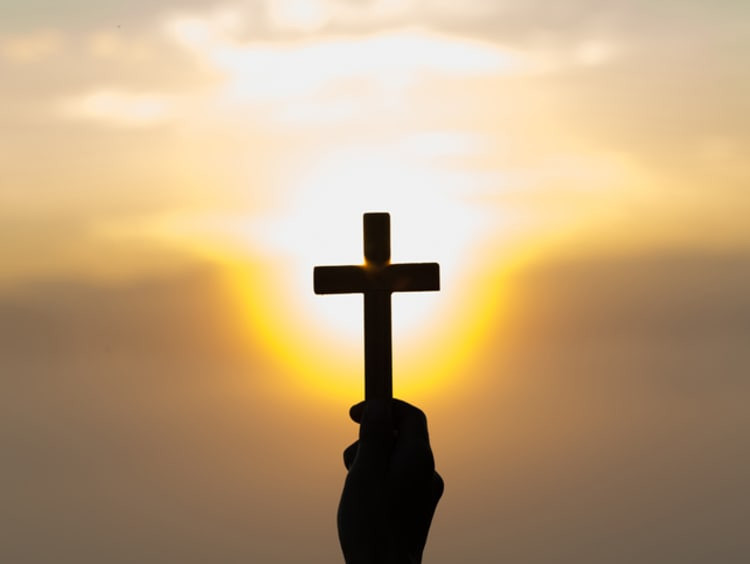
There never existed but one Being who in truth could affirm of His work —“It is finished!” There never was but one Man who could gaze with complacency upon His work, and with His expiring breath, exclaim, “It is finished!”
That man was the God-Man, Mediator, who, as the Son, and yet the Servant of the Father, relinquished His throne for a cross, that He might accomplish the redemption, work out the salvation of His church the people given to Him of God and who, on the eve of that redemption, and with all the certainty of an actual atonement, could thus breathe His intercessory petition to heaven, “I have finished the work which thou gave me to do.” His death, His obedience was the obedience of the law-maker in the form of the law-fulfiller to a law which man had broken and violated. And that obedience perfect and complete, so that broken law is the righteousness that justifies the ungodly, and places him that believes spotless before God.
The idea that Christ’s atoning work is ‘finished’ is scriptural in origin; it is indeed based on a word uttered by our Lord Himself before His death on the cross. We read that Jesus said, ‘tetšlestai — it is finished: and he bowed his head, and gave up his spirit. Clearly, therefore, when Jesus at last reached the point of departure from this present earthly life, the work to which this word tetšlestai referred was already fully accomplished. Similarly, the doctrine to which such plain scriptural witness gave rise, that Christ by His death has done all that was necessary to reconcile sinful men to God, was equally clearly a precious conviction of many of our Christian forebears. They gloried in ‘the finished work of Christ.”
“It is finished” (John 19:30). These were the words of our Lord Jesus Christ as He was dying on the cross. This verse continues “…And he bowed his head and gave up the ghost”. I want to open that phrase “it is finished” to you. I believe you’ll find something fresh here that will fill your heart with deep gratitude.
Those words “it is finished” is a translation of the Greek word tetšlestai a word that means to end, to bring to completion, to bring to a conclusion, to complete, to accomplish, to fulfill, or to finish. There were many nuances to this word, but four have great significance concerning this defining moment of Christ’s sacrifice on the cross. First this was Jesus’ exclamation that He had finished the work the Father had sent Him to do.
According to Pastor Renner, quoting another scholar, when a servant was sent on a mission and then later returned to his master, the servant would say, “tetšlestai” — meaning, “I have done exactly what you requested” or, “The mission is now accomplished.” This is the very message Jesus spoke when He said, “it is finished”.
This means in that moment when Jesus cried out, He was exclaiming to the entire universe that He had faithfully fulfilled the Father’s will and the mission was now accomplished. No wonder Jesus shouted — for this was the greatest victory in the history of the human race! He had been faithful to His assignment even in the face of unfathomable challenges. The fight was over and Jesus could cry out to the Father, “I have done exactly what you asked me to do!” or, “The mission is accomplished.
Second, this word “tetelestai” was the equivalent of the Hebrew word spoken by the high priest when he presented a sacrificial lamb without blemish. Annually, the high priest entered beyond the veil into the Holy of Holies, where he poured the blood of the sacrificial spotless lamb on the mercy seat of the Ark of the Covenant. The moment the blood touched the mercy seat, atonement was made for the people’s sins for one more year. This was done year after year to obtain the annual, temporary forgiveness of sin.
- Ordinary citizens or foreign capital? July Moyo must choose
- Grace tidings: Relax it is a done deal
- Grace tidings: Relax it is a done deal
- Unpacking Christ; our wisdom (2)
Keep Reading
When Jesus hung on the cross, however, He was both Lamb and High Priest. In that holy moment as our Great High Priest, Jesus offered His own blood for the permanent removal of sin. He offered up the perfect sacrifice of His own blood, of which every Old Testament sacrifice was a type and symbol — and in that instant, there remained no more need of offering for sin.
Jesus entered into the Holy Place and offered His own blood, a sacrifice so complete that God never again required the blood of lambs for the forgiveness of sin. As Hebrews 9:12 says, “Neither by the blood of goats and calves, but by his own blood he entered in once into the holy place, having obtained eternal redemption for us.” Thus, when Jesus said, “it is finished!” He was declaring the end of sacrifice, because the ultimate Sacrifice had finally been made! Atonement was completed, perfected, and fully accomplished. It was done once and for all —finished forever.
Third, in a secular sense, “tetelestai” was used in the business world to signify the full payment of a debt. When a debt had been fully paid off, the parchment on which the debt was recorded was stamped with tetelestai, which meant the debt had been paid in full. This means that once a person calls Jesus the Lord of his or her life and personally accepts His sacrifice, no debt of sin exists for that person any longer. The debt is wiped out because Jesus paid the price for sin that no sinner could ever pay.
Jesus took our place. He paid the debt we owed for our sin. And when we, by faith, repent and receive Him as Lord, we are set free! This is why Paul wrote, “In whom we have redemption through his blood, even the forgiveness of sins” (Colossians 1:14).
When Jesus uttered those words “it is finished!” it was His declaration that the debt was fully satisfied, fulfilled, and complete. His blood utterly and completely cleansed us forever. It was far-reaching and all-embracing for all of us who put our faith in Him.
Fourth, in ancient times, “tetelestai” also depicted a turning point when one period ended and a new period began.
When Jesus exclaimed, “It is finished!” it was a turning point in the entire history of mankind. At that moment, the Old Testament came to an end — it was finished and closed — and the New Testament began. The cross was “the Great Divide” in human history. When Jesus cried out, “it is finished” He was shouting that the Old Covenant had ended and the New Covenant had begun.
In that divine moment when Jesus cried, “It is finished,” all the Old Testament prophecies about Jesus’ earthly ministry were fulfilled. The justice of God had been fully satisfied by the Lamb of God. At that moment, the sacrifices of the Old Testament permanently ceased, for the perfect Sacrifice had laid down His life for the salvation of mankind. Jesus’ mission was accomplished. Thus, He could cry out that His task was complete.
Never forget that because Jesus was willing to offer His own blood for the full payment of our sinful debt, we are forgiven and utterly debt-free. The words “paid in full” were stamped on your past sinful record because Jesus paid the price for your redemption with His own blood. Jesus paid the price for salvation, liberation, physical healing, and complete restoration. When the price for your forgiveness was paid in full, Jesus bowed His head and died. God’s justice had been fulfilled. The Old Covenant had ended, and the New Covenant had begun. It was the fulfillment of one and the beginning of another.
He had finished all that justice asked, that the law demanded. He had finished the mission His Father had confided to His hands. He had finished the grand oblation that was to restore to God’s moral government the glory it had lost in man’s apostasy. He had finished all the ancient types, predictions, and shadows. He tore the veil in twain and opened the bright pathway for the sinner to retrace his steps back to paradise, back to God, and once more feel the warm embrace of his Father’s forgiving love.










